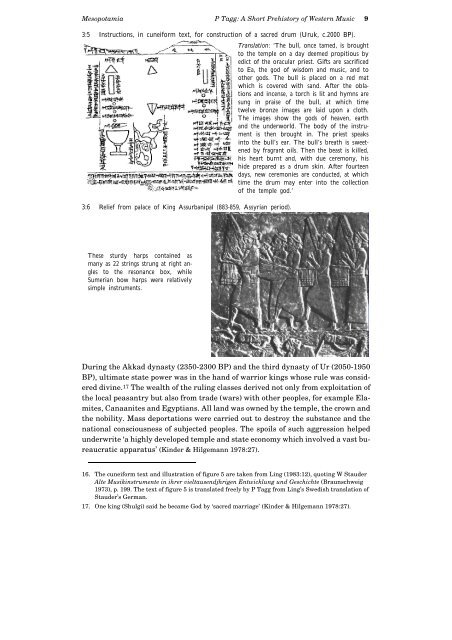A Short Prehistory of Western Music, Chapter 3
A Short Prehistory of Western Music, Chapter 3
A Short Prehistory of Western Music, Chapter 3
Create successful ePaper yourself
Turn your PDF publications into a flip-book with our unique Google optimized e-Paper software.
Mesopotamia P Tagg: A <strong>Short</strong> <strong>Prehistory</strong> <strong>of</strong> <strong>Western</strong> <strong>Music</strong> 9<br />
3:5 Instructions, in cuneiform text, for construction <strong>of</strong> a sacred drum (Uruk, c.2000 BP).<br />
3:6 Relief from palace <strong>of</strong> King Assurbanipal (883-859, Assyrian period).<br />
These sturdy harps contained as<br />
many as 22 strings strung at right angles<br />
to the resonance box, while<br />
Sumerian bow harps were relatively<br />
simple instruments.<br />
Translation: ‘The bull, once tamed, is brought<br />
to the temple on a day deemed propitious by<br />
edict <strong>of</strong> the oracular priest. Gifts are sacrificed<br />
to Ea, the god <strong>of</strong> wisdom and music, and to<br />
other gods. The bull is placed on a red mat<br />
which is covered with sand. After the oblations<br />
and incense, a torch is lit and hymns are<br />
sung in praise <strong>of</strong> the bull, at which time<br />
twelve bronze images are laid upon a cloth.<br />
The images show the gods <strong>of</strong> heaven, earth<br />
and the underworld. The body <strong>of</strong> the instrument<br />
is then brought in. The priest speaks<br />
into the bull’s ear. The bull’s breath is sweetened<br />
by fragrant oils. Then the beast is killed,<br />
his heart burnt and, with due ceremony, his<br />
hide prepared as a drum skin. After fourteen<br />
days, new ceremonies are conducted, at which<br />
time the drum may enter into the collection<br />
<strong>of</strong> the temple god.’<br />
During the Akkad dynasty (2350-2300 BP) and the third dynasty <strong>of</strong> Ur (2050-1950<br />
BP), ultimate state power was in the hand <strong>of</strong> warrior kings whose rule was considered<br />
divine. 17 The wealth <strong>of</strong> the ruling classes derived not only from exploitation <strong>of</strong><br />
the local peasantry but also from trade (wars) with other peoples, for example Elamites,<br />
Canaanites and Egyptians. All land was owned by the temple, the crown and<br />
the nobility. Mass deportations were carried out to destroy the substance and the<br />
national consciousness <strong>of</strong> subjected peoples. The spoils <strong>of</strong> such aggression helped<br />
underwrite ‘a highly developed temple and state economy which involved a vast bureaucratic<br />
apparatus’ (Kinder & Hilgemann 1978:27).<br />
16. The cuneiform text and illustration <strong>of</strong> figure 5 are taken from Ling (1983:12), quoting W Stauder<br />
Alte Musikinstrumente in ihrer vieltausendjhrigen Entwicklung und Geschichte (Braunschweig<br />
1973), p. 199. The text <strong>of</strong> figure 5 is translated freely by P Tagg from Ling’s Swedish translation <strong>of</strong><br />
Stauder’s German.<br />
17. One king (Shulgi) said he became God by ‘sacred marriage’ (Kinder & Hilgemann 1978:27).














